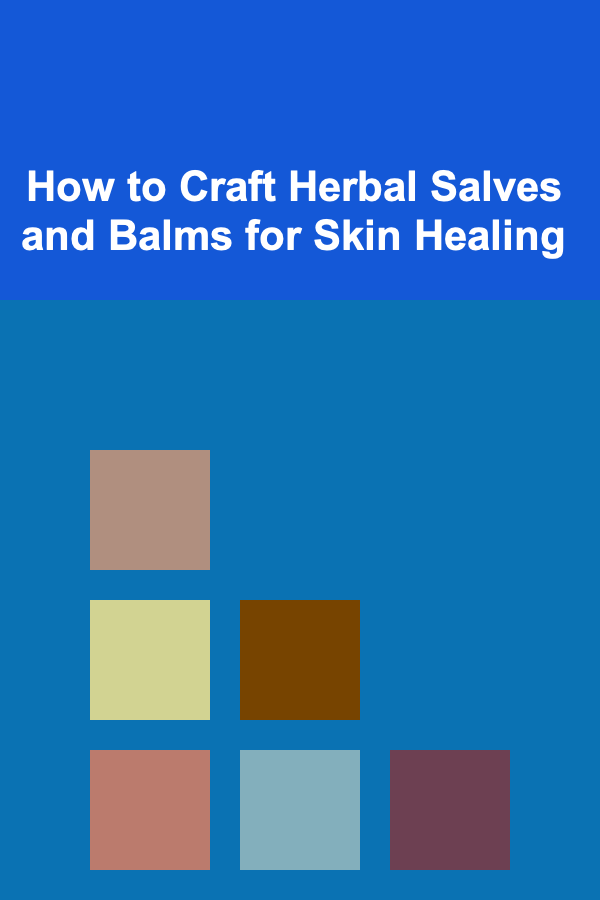
How to Craft Herbal Salves and Balms for Skin Healing
ebook include PDF & Audio bundle (Micro Guide)
$12.99$5.99
Limited Time Offer! Order within the next:

Herbal salves and balms have been used for centuries across cultures as natural remedies for skin ailments, minor wounds, and irritations. Their gentle yet effective healing properties, combined with the nourishing benefits of herbs and natural oils, make them a cherished alternative to synthetic creams and ointments. Crafting these herbal preparations at home offers not only a chance to connect with nature but also to create personalized remedies tailored to individual skin needs.
This comprehensive guide will take you through the art and science of making herbal salves and balms. We will explore the principles behind these healing concoctions, the key ingredients and their roles, techniques for preparation, and safety considerations. By the end, you will have both the knowledge and confidence to craft your own herbal salves for skin healing.
Understanding Herbal Salves and Balms
What Are Salves and Balms?
Herbal salves and balms are topical preparations designed to soothe, protect, and heal the skin. Both are semi-solid at room temperature and typically made by infusing herbs in carrier oils, then blending these oils with a thickening agent such as beeswax. The terms "salve" and "balm" are often used interchangeably, though balms tend to have a slightly thicker consistency and sometimes contain additional ingredients like butters (shea, cocoa) or essential oils.
The Healing Power of Herbal Salves
Herbal salves combine the therapeutic properties of plants with the emollient and protective qualities of oils and waxes. They are typically applied to:
- Cuts, scrapes, and minor wounds
- Burns and sunburns
- Dry, cracked, or chapped skin
- Insect bites and stings
- Skin inflammations like eczema and psoriasis
- Muscle aches and joint pains (when infused with specific herbs)
The topical application allows active constituents of herbs to penetrate the skin and promote healing locally, while the oils provide moisture and protection against environmental irritants.
The Science Behind Herbal Salves: Key Ingredients and Their Functions
Creating effective herbal salves requires an understanding of the main ingredients and their roles in the formulation.
1. Carrier Oils
Carrier oils form the base of your salve and act as the medium that delivers the herbal benefits to the skin. They are typically vegetable oils extracted from nuts, seeds, or fruits.
Characteristics to consider:
- Absorption Rate: Light oils like jojoba or sweet almond oil absorb quickly, ideal for oily or sensitive skin. Heavier oils like olive or avocado oil provide deep nourishment, suitable for dry or mature skin.
- Stability: Some oils are prone to rancidity; those rich in antioxidants (e.g., coconut oil, olive oil) tend to last longer.
- Therapeutic Properties: Many carrier oils have their own skin benefits, such as anti-inflammatory, moisturizing, or antimicrobial effects.
Common carrier oils:
- Olive oil
- Coconut oil
- Jojoba oil
- Sweet almond oil
- Avocado oil
- Grapeseed oil
2. Herbs
Herbs provide the active healing constituents. They can be infused into the carrier oils to extract beneficial compounds like flavonoids, tannins, alkaloids, and essential oils.
Methods of incorporating herbs:
- Infused oils: Herbs steeped in oils over time (cold infusion) or gently heated (warm infusion) to extract their essence.
- Powders: Finely ground herbs can be mixed directly into the salve for added texture and potency.
- Essential oils: Concentrated volatile oils distilled from plants, used sparingly for their therapeutic and aromatic properties.
Popular skin-healing herbs:
- Calendula (Calendula officinalis): Anti-inflammatory, antimicrobial, promotes wound healing.
- Comfrey (Symphytum officinale): Supports skin repair, reduces inflammation.
- Plantain (Plantago major): Soothes irritated skin, anti-inflammatory.
- Lavender (Lavandula angustifolia): Antimicrobial, calming, aids in healing burns.
- Chamomile (Matricaria chamomilla): Anti-inflammatory, soothing.
- St. John's Wort (Hypericum perforatum): Antibacterial, antiviral, promotes skin regeneration.
3. Beeswax
Beeswax is the thickening agent that transforms the infused oil into a semi-solid form, giving salves their characteristic texture and stability. It also acts as a protective barrier on the skin, helping to lock in moisture and shield wounds from dirt and pathogens.
- The amount of beeswax controls the firmness of the final product: more beeswax means a harder salve.
- Beeswax has its own mild antimicrobial properties.
- Alternatives like candelilla wax or carnauba wax are used in vegan formulations but have different melting points and textures.
4. Optional Additives
- Butters (shea, cocoa): Add richness and creaminess to balms, increasing moisturizing properties.
- Vitamin E oil: Acts as a natural preservative and skin nutrient.
- Essential oils: Added for scent and additional therapeutic benefits, but must be used cautiously due to potency.
Step-by-Step Guide to Making Herbal Salves
Step 1: Prepare Your Herbal Infused Oil
The first and most critical step is making a high-quality herbal infused oil.
Cold Infusion Method:
- Place dried herbs in a clean, dry glass jar. Fill it about halfway.
- Pour carrier oil over the herbs until completely submerged.
- Seal the jar tightly and place it in a warm, sunny window for 4-6 weeks.
- Shake the jar daily to mix herbs and oil.
- After the infusion period, strain the oil through a fine mesh or cheesecloth, discarding the herbs.
Warm Infusion Method:
- Combine dried herbs and carrier oil in a double boiler or slow cooker.
- Heat gently at a low temperature (95-115°F / 35-46°C) for 4-6 hours, stirring occasionally.
- Strain the oil and store in a clean container.
Note: Use dried herbs for infusions to prevent mold. Fresh herbs can be used but require more care and faster processing.
Step 2: Measure Ingredients
For a basic salve:
- 1 cup herbal infused oil
- 1 oz beeswax (approx. 2 tablespoons)
- Optional: 1-2 teaspoons of butters or vitamin E oil
- Optional: 10-20 drops of essential oils
You can adjust the beeswax ratio to change firmness: use more for a solid balm, less for a softer salve.
Step 3: Melt and Mix
- Place the beeswax and butters (if using) in a double boiler or heat-safe bowl over simmering water.
- Once melted, add the herbal infused oil and stir to combine.
- Remove from heat and add vitamin E oil and essential oils.
- Stir thoroughly.
Step 4: Pour and Cool
- Pour the mixture into clean, sterilized containers (tin tins, glass jars, or lip balm tubes).
- Allow to cool and solidify at room temperature. This usually takes 1-2 hours.
- Cap or cover the containers and label them with the date and ingredients.
Tips for Successful Salve Making
- Sterilize Containers: To prevent contamination, clean and sterilize all jars and tools before use.
- Use Quality Ingredients: Organic herbs and cold-pressed oils yield the best results.
- Work in Small Batches: Especially when starting out, smaller batches help avoid waste and allow experimentation.
- Test Your Salve: Before widespread use, patch test the salve on a small skin area to check for sensitivity.
- Adjust Consistency: If your salve is too soft, remelt and add more beeswax; if too hard, add more oil.
- Store Properly: Keep salves in a cool, dark place to extend shelf life. Most salves last 6-12 months.
Understanding the Healing Properties of Popular Herbs
Calendula (Calendula officinalis)
Known as the "marigold," calendula is prized for its wound-healing and anti-inflammatory properties. Studies have demonstrated calendula's ability to speed up skin repair and reduce swelling, making it ideal for minor cuts, scrapes, and rashes.
Comfrey (Symphytum officinale)
Comfrey contains allantoin, a compound that promotes new cell growth and soothes inflammation. It has been traditionally used to treat bruises, sprains, and skin irritations. However, comfrey should be used externally only, as internal use can be toxic.
Plantain (Plantago major)
Plantain is a powerful anti-inflammatory herb that calms irritated skin and helps heal wounds. It is particularly effective for insect bites, poison ivy, and minor burns.
Lavender (Lavandula angustifolia)
Lavender essential oil is celebrated for its antiseptic and anti-inflammatory properties. It can aid in healing burns, cuts, and acne while providing a calming scent.
Chamomile (Matricaria chamomilla)
Chamomile soothes the skin and reduces redness and itching, especially useful for eczema and sensitive skin.
Safety Considerations and Contraindications
- Allergic Reactions: Always conduct a patch test before using a new salve. Stop use if irritation occurs.
- Herb Safety: Some herbs (like comfrey) are unsafe for internal use or during pregnancy. Research each herb thoroughly.
- Essential Oils: These are potent and must be diluted. Avoid photosensitizing oils (e.g., bergamot) if you plan sun exposure.
- Storage: Herbal salves have limited shelf lives. Discard if you notice rancid smells, discoloration, or mold.
Beyond Skin Healing: Other Uses of Herbal Salves and Balms
While primarily for skin healing, salves can be tailored for additional uses:
- Muscle Relief: Adding herbs like arnica, cayenne, or ginger can create warming balms to soothe muscle aches.
- Lip Care: Thicker, emollient-rich balms protect chapped lips.
- Baby Care: Gentle, calendula-based salves are excellent for diaper rash and cradle cap.
- After-Sun Care: Cooling herbs like aloe or peppermint can be infused to soothe sun-exposed skin.
Crafting Your Personalized Herbal Salve: Experimentation and Customization
One of the joys of making herbal salves is the ability to customize formulations to suit specific needs or preferences.
- Blend Herbs: Combine different herbal infused oils for synergistic effects, e.g., calendula for healing and lavender for antimicrobial.
- Adjust Texture: Play with ratios of beeswax and butters to create anything from soft ointments to hard balms.
- Create Signature Scents: Mix essential oils like eucalyptus, rosemary, or citrus to create pleasant aromas.
- Incorporate Modern Additives: Ingredients like CBD oil or colloidal oatmeal can enhance therapeutic benefits.
Document your recipes and observations carefully to replicate successful batches and improve over time.
Final Thoughts
Crafting herbal salves and balms is both an art and a science that connects us to traditional healing practices and the natural world. By understanding the properties of carrier oils, herbs, and waxes, and following careful preparation methods, you can create effective, nourishing salves that support skin healing in a gentle and holistic way.
Whether you're seeking remedies for dry skin, minor wounds, or inflammation, homemade herbal salves offer a personalized, eco-friendly, and empowering approach to skin care. With patience and practice, you can confidently craft your own healing salves and enrich your wellness routine with the gifts of nature.
If you'd like, I can also provide some detailed recipes or troubleshooting tips for specific skin conditions or herbs. Just let me know!
Reading More From Our Other Websites
- [Soap Making Tip 101] Eco-Friendly Soap Making: Sustainable Herbs and Natural Ingredients
- [Personal Care Tips 101] How to Use Body Wash to Balance Your Skin's Natural Oils
- [Tiny Home Living Tip 101] Best Tiny Home Bathroom Designs: Compact, Luxurious, & Space‑Saving Solutions
- [Home Cleaning 101] How to Get Rid of Pet Hair from Every Surface
- [Personal Investment 101] How to Invest in Real Estate with Little or No Money Down
- [Organization Tip 101] How to Choose the Best Foundation for Your Garden Shed
- [Home Family Activity 101] How to Get Creative with Family Art and Craft Projects
- [Personal Care Tips 101] How to Use Toothpaste to Help Maintain Your Dental Fillings
- [Personal Investment 101] How to Build an AI-Powered Business That Generates Passive Income
- [Biking 101] Why Supporting Local Bike Shops Makes a Difference

From Content to Conversion: A Social Media Manager's Roadmap to Results
Read More
How To Improve Your Sleep Through Psychology
Read More
How to Remove Mold and Mildew from Your Bathroom
Read More
How To Foster Innovation Within Your Company
Read More
How to Conduct Safe Rocket Launches: Safety Guidelines & Best Practices
Read More
How to Navigate Complex ERP Data Migration
Read MoreOther Products

From Content to Conversion: A Social Media Manager's Roadmap to Results
Read More
How To Improve Your Sleep Through Psychology
Read More
How to Remove Mold and Mildew from Your Bathroom
Read More
How To Foster Innovation Within Your Company
Read More
How to Conduct Safe Rocket Launches: Safety Guidelines & Best Practices
Read More